
Silver dapple gene
Encyclopedia
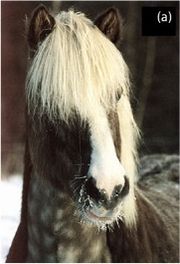
Dilution gene
Dilution gene is a popular term for any one of a number of genes that act to create a lighter coat color in living creatures. There are many examples of such genes:-General:...
that affects the black
Black (horse)
Black is a hair coat color of horses in which the entire hair coat is black. Black is a relatively uncommon coat color, and novices frequently mistake dark chestnuts or bays for black. However, some breeds of horses, such as the Friesian horse, Murgese and Ariegeois are almost exclusively black...
base coat color
Equine coat color
Horses exhibit a diverse array of coat colors and distinctive markings. A specialized vocabulary has evolved to describe them.While most horses remain the same color throughout life, a few, over the course of several years, will develop a different coat color from that with which they were born...
. It will typically dilute a black mane and tail to flaxen, and a black body to a shade of brown or chocolate. It is responsible for a group of coat colors
Equine coat color
Horses exhibit a diverse array of coat colors and distinctive markings. A specialized vocabulary has evolved to describe them.While most horses remain the same color throughout life, a few, over the course of several years, will develop a different coat color from that with which they were born...
in horses called "silver dapple" in the west, or "taffy" in Australia. The most common colors in this category are black
Black (horse)
Black is a hair coat color of horses in which the entire hair coat is black. Black is a relatively uncommon coat color, and novices frequently mistake dark chestnuts or bays for black. However, some breeds of horses, such as the Friesian horse, Murgese and Ariegeois are almost exclusively black...
silver and bay silver, referring to the respective underlying coat color.
Mature black silvers typically have sooty white or silver mane
Mane (horse)
The mane is the hair that grows from the top of the neck of a horse or other equine, reaching from the poll to the withers, and includes the forelock or foretop. It is thicker and coarser than the rest of the horse's coat, and naturally grows to roughly cover the neck...
s and tails with a flat, non-fading, dark grey or grey-brown body coat. The body coat frequently exhibits dapples, rings of lighter-colored hair.
Mature bay silvers retain their reddish bodies, though the presence of small amounts of silver often gives them a chocolate appearance. The mane and tail are usually a sooty silver, darker at the roots, and the legs are usually a flat, brownish-grey mottled with silver. The hair around the eyes and muzzle may also show signs of silvering.
Silver dapple foal
Foal
A foal is an equine, particularly a horse, that is one year old or younger. More specific terms are colt for a male foal and filly for a female foal, but these terms are used until the horse is age three or four. When the foal is nursing from its dam , it may also be called a suckling...
s can be difficult to identify, but commonly have a pale, wheat-colored body coat, white eyelashes, and hooves
Hoof
A hoof , plural hooves or hoofs , is the tip of a toe of an ungulate mammal, strengthened by a thick horny covering. The hoof consists of a hard or rubbery sole, and a hard wall formed by a thick nail rolled around the tip of the toe. The weight of the animal is normally borne by both the sole...
with tapering vertical stripes. These characteristics fade over time.
Red-based horses, such as chestnut
Chestnut (coat)
Chestnut is a hair coat color of horses consisting of a reddish-to-brown coat with a mane and tail the same or lighter in color than the coat. Genetically and visually, chestnut is characterized by the absolute absence of true black hairs...
s and chestnuts with other dilution factors (such as palomino
Palomino
Palomino is a coat color in horses, consisting of a gold coat and white mane and tail. Genetically, the palomino color is created by a single allele of a dilution gene called the cream gene working on a "red" base coat...
s, and cremello) may carry the silver dapple gene, and may pass it on to their offspring, but will not express the gene in their own body color.
Silver mimics
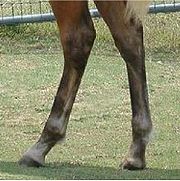
- GrayGray (horse)Gray or grey is a coat color of horses characterized by progressive silvering of the colored hairs of the coat. Most gray horses have black skin and dark eyes; unlike many depigmentation genes, gray does not affect skin or eye color Their adult hair coat is white, dappled, or white intermingled...
: While gray horses grow progressively lighter, silver dapples often darken with age. A silver dapple masked by gray (i.e. carries both genes and, because gray is a dominant geneDominance relationshipDominance in genetics is a relationship between two variant forms of a single gene, in which one allele masks the effect of the other in influencing some trait. In the simplest case, if a gene exists in two allelic forms , three combinations of alleles are possible: AA, AB, and BB...
, becomes white with age) may be identified by use of DNA testingGenetic fingerprintingDNA profiling is a technique employed by forensic scientists to assist in the identification of individuals by their respective DNA profiles. DNA profiles are encrypted sets of numbers that reflect a person's DNA makeup, which can also be used as the person's identifier...
. - Liver chestnutChestnut (coat)Chestnut is a hair coat color of horses consisting of a reddish-to-brown coat with a mane and tail the same or lighter in color than the coat. Genetically and visually, chestnut is characterized by the absolute absence of true black hairs...
: Silver dapples, especially bay silvers, are frequently misidentified as liver chestnuts or flaxen chestnuts. Flaxen (blond) manes and tails in chestnuts tend to have honey or red tones, while the pale manes and tails of silver dapples are soot-toned and darker at the roots. Liver chestnuts also lack the grey-brown dappling on the lower legs. The darkest liver chestnuts often have a kind of marbling on the lower legs, though this hair, too, should show red or yellow tones. Overall, chestnuts of all shades have red-yellow character to their coats, while silver bays recall grey-brown. Knowledge of the pedigree of the horse in question is often useful: two chestnut-based parents cannot produce a silver bay or silver black. DNA testing can be used in the most difficult cases. - "Sooty" palominoPalominoPalomino is a coat color in horses, consisting of a gold coat and white mane and tail. Genetically, the palomino color is created by a single allele of a dilution gene called the cream gene working on a "red" base coat...
: Dark palominos may be hard to distinguish from silver dapples, particularly if the maneMane- Biology :* mane of a horse, the line of hair along the spine of the neck* mane of a lion, found around the male mammal's neck- Places :* Mane Department, a department in the Sanmatenga Province of Burkina Faso* French communes:...
or tail of a palomino contain streaks of silver. A true palomino, with a red-basedChestnut (coat)Chestnut is a hair coat color of horses consisting of a reddish-to-brown coat with a mane and tail the same or lighter in color than the coat. Genetically and visually, chestnut is characterized by the absolute absence of true black hairs...
coat, will exhibit yellow or gold tones; a silver horse, in contrast, is by definition black-basedBlack (horse)Black is a hair coat color of horses in which the entire hair coat is black. Black is a relatively uncommon coat color, and novices frequently mistake dark chestnuts or bays for black. However, some breeds of horses, such as the Friesian horse, Murgese and Ariegeois are almost exclusively black...
and exhibits gray, black or brown undertones. A sooty palomino, like other creme dilutesCream geneThe cream gene is responsible for a number of horse coat colors. Horses that have the cream gene in addition to a base coat color that is chestnut will become palomino if they are heterozygous, having one copy of the cream gene, or cremello, if they are homozygous. Similarly, horses with a bay...
, may have brown eyes a shade lighter than average, but this is not true of silver dapples. When actual color is in question, pedigree information or a DNADNADeoxyribonucleic acid is a nucleic acid that contains the genetic instructions used in the development and functioning of all known living organisms . The DNA segments that carry this genetic information are called genes, but other DNA sequences have structural purposes, or are involved in...
test can help clarify matters.
Prevalence
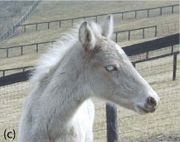
Breed
A breed is a group of domestic animals or plants with a homogeneous appearance, behavior, and other characteristics that distinguish it from other animals or plants of the same species. Despite the centrality of the idea of "breeds" to animal husbandry, there is no scientifically accepted...
s do not possess the silver dapple gene
Gene
A gene is a molecular unit of heredity of a living organism. It is a name given to some stretches of DNA and RNA that code for a type of protein or for an RNA chain that has a function in the organism. Living beings depend on genes, as they specify all proteins and functional RNA chains...
. The coat color is traditionally associated with the Rocky Mountain Horse
Rocky Mountain Horse
Around the turn of the 20th century, a young horse soon to be called the Rocky Mountain Horse appeared in eastern Kentucky that gave rise to a line of horses prized by North American and European owners. On the farm of Sam Tuttle in Spout Springs Kentucky, there stood a stallion "Old Tobe"...
and the Miniature Horse
Miniature horse
Miniature horses are found in many nations, particularly in Europe and the Americas. The designation of miniature horse is determined by the height of the animal, which, depending on the particular breed registry involved, is usually less than as measured at the last hairs of the mane, which are...
. Scandinavia
Scandinavia
Scandinavia is a cultural, historical and ethno-linguistic region in northern Europe that includes the three kingdoms of Denmark, Norway and Sweden, characterized by their common ethno-cultural heritage and language. Modern Norway and Sweden proper are situated on the Scandinavian Peninsula,...
n breeds and their descendants such as the Icelandic horse
Icelandic horse
The Icelandic horse is a breed of horse developed in Iceland. Although the horses are small, at times pony-sized, most registries for the Icelandic refer to it as a horse. Icelandic horses are long-lived and hardy. In their native country they have few diseases; Icelandic law prevents horses from...
, Nordland Pony, Shetland Pony
Shetland pony
The Shetland pony is a breed of pony originating in the Shetland Isles. Shetlands range in size from a minimum height of approximately 28 inches to an official maximum height of 42 inches at the withers. Shetland ponies have heavy coats, short legs and are considered quite intelligent...
, Welsh Mountain Pony, Welsh Pony, Swedish Warmblood
Swedish Warmblood
The Swedish Warmblood is a horse that was developed at Strömsholm and Flyinge. It descends from imported stock in the 17th century. The horses imported to Sweden were from Denmark, Germany, England, Hungary, France, Russia, Spain, and Turkey...
and Finnhorse
Finnhorse
The Finnhorse or Finnish Horse is a horse breed with both riding horse and draught horse influences and characteristics, and is the only breed developed fully in Finland...
are also found in the silver dapple colors. American horse breeds known to have the silver gene include the Morgan
Morgan horse
The Morgan is one of the earliest horse breeds developed in the United States. Tracing back to the stallion Figure, later named Justin Morgan after his best-known owner, the breed excels in many disciplines, and is known for its versatility....
, American Saddlebred
American Saddlebred
The American Saddlebred, formerly known as the American Saddle Horse, is a breed of horse that was developed in Kentucky by plantation owners. Today, in the horse show world, they are most commonly seen under saddle in Saddle seat style riding, and in various types of driving, including pleasure...
, Missouri Foxtrotter
Missouri Fox Trotter
The Missouri Fox Trotter is an American breed of horse with a unique four beat gait. It was bred in the Ozark Mountain foothills, and used by settlers who valued its smoothness.-Breed characteristics:...
, Tennessee Walking Horse
Tennessee Walker
The Tennessee Walker or Tennessee Walking Horse is a breed of riding horse. The breed was originally bred in the Southern United States to carry the owners of plantations around their lands...
, and the American Quarter Horse
American Quarter Horse
The American Quarter Horse is an American breed of horse that excels at sprinting short distances. Its name came from its ability to outdistance other breeds of horses in races of a quarter mile or less; some individuals have been clocked at speeds up to 55 mph...
. European draft
Draft horse
A draft horse , draught horse or dray horse , less often called a work horse or heavy horse, is a large horse bred for hard, heavy tasks such as ploughing and farm labour...
breeds such as the Comtois
Comtois (horse)
The Comtois horse is a draft horse that originated in the Jura Mountains on the border between France and Switzerland.- Characteristics :...
and Ardennais
Ardennes (horse)
The Ardennes or Ardennais is one of the oldest breeds of draft horse, and originates from the Ardennes area in Belgium, Luxembourg and France. They are heavy-boned with thick legs and are used for draft work. The Ardennes is found in many colors, although black horses are very rare and are not...
also occur in silver. Historically the color was found in the Dutch Groningen
Groningen Horse
The Groningen Horse is a Dutch horse breed developed for light draft and agricultural work. It is closely related to heavy warmblood breeds like the East Friesian and Alt-Oldenburger...
, but the breed was crossbred to produce the Dutch Warmblood
Dutch Warmblood
A Dutch Warmblood is a warmblood type of horse registered with the Koninklijk Warmbloed Paardenstamboek Nederland A Dutch Warmblood is a warmblood type of horse registered with the Koninklijk Warmbloed Paardenstamboek Nederland A Dutch Warmblood is a warmblood type of horse registered with the...
and underwent subsequent genetic bottlenecking, so the gene may no longer be present.
Inheritance and expression
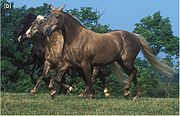
Missense mutation
In genetics, a missense mutation is a point mutation in which a single nucleotide is changed, resulting in a codon that codes for a different amino acid . This can render the resulting protein nonfunctional...
(labeled Z) in the PMEL17
SILV
Melanocyte protein Pmel 17 is a protein that in humans is encoded by the SILV gene. Its gene product may be referred to as silver, ME20, gp100 or Pmel17 and is a 100 kDa type I transmembrane protein...
gene on horse chromosome
Chromosome
A chromosome is an organized structure of DNA and protein found in cells. It is a single piece of coiled DNA containing many genes, regulatory elements and other nucleotide sequences. Chromosomes also contain DNA-bound proteins, which serve to package the DNA and control its functions.Chromosomes...
6. It is transmitted by autosomal dominant inheritance (simple dominance). PMEL17 is active from quite early in embryonic development
Embryogenesis
Embryogenesis is the process by which the embryo is formed and develops, until it develops into a fetus.Embryogenesis starts with the fertilization of the ovum by sperm. The fertilized ovum is referred to as a zygote...
through to the mature cell's melanosome
Melanosome
In a biological cell, a melanosome is an organelle containing melanin, the most common light-absorbing pigment found in the animal kingdom.Cells that synthesize melanins are called melanocytes, and also the retinal pigment epithelium cells, whereas cells that have merely engulfed the melanosomes...
and is involved with the production of the black pigment eumelanin
Melanin
Melanin is a pigment that is ubiquitous in nature, being found in most organisms . In animals melanin pigments are derivatives of the amino acid tyrosine. The most common form of biological melanin is eumelanin, a brown-black polymer of dihydroxyindole carboxylic acids, and their reduced forms...
.
Melanins, which provide color in the eyes, skin, and hair, are found in two types: eumelanin, which produces black to brown pigment, and phaeomelanin, which produces red to yellow pigment. Most horses can produce both types; the brown appearance of a bay horse's coat is caused by alternating bands of eumelanin and phaeomelanin, for which the agouti gene
Agouti signalling peptide
Agouti signalling peptide, a product of the Agouti gene, is a peptide consisting of 131 amino acids. Its discovery was published in 1994 in the scientific journal Nature where its functional properties were described...
is responsible. Eumelanin predominates in the legs, mane and tail of bay horses. By contrast, horses which lack a functional agouti gene cannot produce such alternating bands, and thus have wholly black
Black (horse)
Black is a hair coat color of horses in which the entire hair coat is black. Black is a relatively uncommon coat color, and novices frequently mistake dark chestnuts or bays for black. However, some breeds of horses, such as the Friesian horse, Murgese and Ariegeois are almost exclusively black...
coats with no visible phaeomelanin. Chestnut
Chestnut (coat)
Chestnut is a hair coat color of horses consisting of a reddish-to-brown coat with a mane and tail the same or lighter in color than the coat. Genetically and visually, chestnut is characterized by the absolute absence of true black hairs...
horses lack the ability to manufacture eumelanin altogether, and so have wholly red coats devoid of true black pigment.
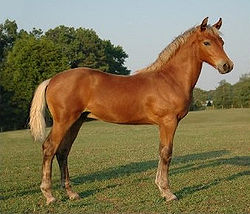
Dilution gene
Dilution gene is a popular term for any one of a number of genes that act to create a lighter coat color in living creatures. There are many examples of such genes:-General:...
, or hypopigmentation, of eumelanin. The dilution changes black into various shades of platinum, silver and flat grey, though the original black-brown character of the color is usually preserved. The effects of the gene are more striking in the mane and tail. Horses with chestnut or chestnut-family coats - such as palomino, red roan, or red dun - are therefore unaffected by the gene and may silently carry it and pass it on to their offspring.
On the template of a black horse, which has a coat rich in eumelanin, the effect is that of complete conversion to varying shades of silver. Often the body remains quite dark while the mane and tail are strongly diluted.
On the template of a bay horse, which has eumelanin largely restricted to the points, these points are converted to silver while the phaeomelanic body is mostly unaffected.
Analogous conditions
Similar mutations in other species provide insight into the roles played by the PMEL17 gene. Relatively few such mutations are known, which suggests that the gene is involved in processes critical to survival. Several of the mutations known are related to pigmentation: premature silvering in miceMouse
A mouse is a small mammal belonging to the order of rodents. The best known mouse species is the common house mouse . It is also a popular pet. In some places, certain kinds of field mice are also common. This rodent is eaten by large birds such as hawks and eagles...
, diluted and white plumage in chicken
Chicken
The chicken is a domesticated fowl, a subspecies of the Red Junglefowl. As one of the most common and widespread domestic animals, and with a population of more than 24 billion in 2003, there are more chickens in the world than any other species of bird...
s, and the widely-known merle
Merle (coat colour in dogs)
Merle is a pattern in a dogs coat, though is commonly incorrectly referred to as a color.- Description :Merle can affect all coat colors but the colors most commonly seen that are affected are brown and black, when affected by merle they are usually called liver and blue, though some call liver red...
dilution in dogs. The merle coat in dogs is associated with auditory
Auditory system
The auditory system is the sensory system for the sense of hearing.- Outer ear :The folds of cartilage surrounding the ear canal are called the pinna...
and ophthalmologic
Visual system
The visual system is the part of the central nervous system which enables organisms to process visual detail, as well as enabling several non-image forming photoresponse functions. It interprets information from visible light to build a representation of the surrounding world...
disorders, such as deafness and microphthalmia
Microphthalmia
Microphthalmia also referred to as microphthalmos, nanophthalmia or nanophthalmos, is a developmental disorder of the eye that literally means small eye...
. In Rocky Mountain Horse
Rocky Mountain Horse
Around the turn of the 20th century, a young horse soon to be called the Rocky Mountain Horse appeared in eastern Kentucky that gave rise to a line of horses prized by North American and European owners. On the farm of Sam Tuttle in Spout Springs Kentucky, there stood a stallion "Old Tobe"...
s, the silver dapple color is sometimes associated with Anterior Segment Dysgenesis
Anterior segment dysgenesis
Anterior segment dysgenesis is a failure of the normal development of the tissues of the anterior segment of the eye. It leads to anomalies in the structure of the mature anterior segment, associated with an increased risk of glaucoma and corneal opacity....
(ASD) which affects the structures in the face and the front of the eye. Most often, the syndrome presents as benign lesion
Lesion
A lesion is any abnormality in the tissue of an organism , usually caused by disease or trauma. Lesion is derived from the Latin word laesio which means injury.- Types :...
s, though homozygotes
Zygosity
Zygosity refers to the similarity of alleles for a trait in an organism. If both alleles are the same, the organism is homozygous for the trait. If both alleles are different, the organism is heterozygous for that trait...
may have impaired vision. As ASD is found in non-silver representatives of the breed, it is thought to be physically close to the silver gene and to have come from a silver dapple, ASD-affected foundation ancestor
Foundation bloodstock
Foundation bloodstock or foundation stock are horses that are the progenitor, or foundation, of a new horse breed or a given bloodline within a breed. The term is also used in a similar manner when discussing purebred dogs...
, thus is an example of the Founder effect
Founder effect
In population genetics, the founder effect is the loss of genetic variation that occurs when a new population is established by a very small number of individuals from a larger population. It was first fully outlined by Ernst Mayr in 1942, using existing theoretical work by those such as Sewall...
.

